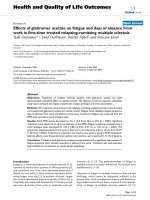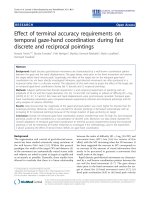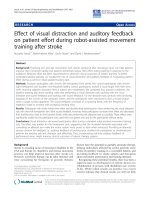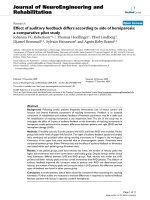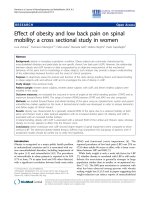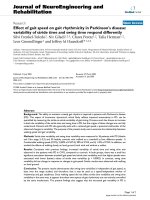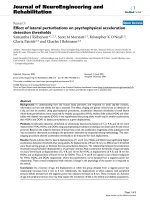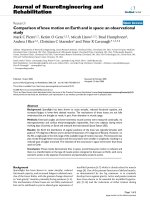Báo cáo hóa học: " Effect of annealing treatments on photoluminescence and charge storage mechanism in silicon-rich SiNx:H films" docx
Bạn đang xem bản rút gọn của tài liệu. Xem và tải ngay bản đầy đủ của tài liệu tại đây (2.15 MB, 10 trang )
NANO EXPRESS Open Access
Effect of annealing treatments on
photoluminescence and charge storage
mechanism in silicon-rich SiN
x
:H films
Bhabani Shankar Sahu
*
, Florian Delachat, Abdelilah Slaoui, Marzia Carrada, Gerald Ferblantier, Dominique Muller
Abstract
In this study, a wide range of a-SiN
x
:H films with an excess of silicon (20 to 50%) were prepared with an electron-
cyclotron resonance plasma-enhanced chemical vapor deposition system under the flows of NH
3
and SiH
4
. The
silicon-rich a-SiN
x
:H films (SRSN) were sandwiched between a bottom thermal SiO
2
and a top Si
3
N
4
layer, and
subsequently annealed within the temperature range of 500-1100°C in N
2
to study the effect of annealing
temperature on light-emi tting and charge storage properties. A strong visible photoluminescence (PL) at room
temperature has been observed for the as-deposited SRSN films as well as for films annealed up to 1100°C. The
possible origins of the PL are briefly discussed. The authors have succeeded in the formation of amorphous Si
quantum dots with an average size of about 3 to 3.6 nm by varying excess amount of Si and annealing
temperature. Electrical properties have been investigated on Al/Si
3
N
4
/SRSN/SiO
2
/Si structures by capacitance-
voltage and conductance-voltage analysis techniques. A significant memory window of 4.45 V was obtained at a
low operating voltage of ± 8 V for the sample containing 25% excess silicon and annealed at 1000°C, indicating its
utility in low-power memory devices.
Introduction
Silicon nitride-based dielectrics are drawing considerable
attention because of their utility in a wide variety of
electronic and optoelectronic applications due to their
compa tibility with the existing mainstream CMOS tech-
nology and tunable emission in visible range, which can
be applied for developing non-volatile memories and Si-
based light-emitting diodes [1-6]. The field strength is
needed for electroluminescence in SiO
x
close to the
breakdown strength of silicon oxide (6-10 MV/cm)
[7,8]. In this regard, SiN
x
can be a better choice , as the
field needed to inject electrons and holes (2-4 MV/cm)
is weaker than that of SiO
2
, and is much lower than the
breakdown strength of Si
3
N
4
(9 MV/cm) [9,10]. Even if
the band gap of Si
3
N
4
is approximately 5.3 eV (8.2 eV
for SiO
2
), it should be sufficient to confine charge car-
riers into SiN
x
matrix [11]. In addition, SRSN also con-
tains a high density of deep level electron a nd hole
traps, which can give rise to a strong trapping of elec-
trons and holes, indicat ing its utility for light-emitting
as well as charge storage devices. Another major interest
for using silicon nitride rather than silicon oxide is the
possibility of obtaining efficient emission at relatively
shorter wavelength. Several authors have reported
intense luminescence in blue-green region, which is very
rare in silicon oxide-based materials [12,13] and there-
fore provides the possibility for fabricating full-color
devices based on silicon technology. Pr evious studies
revealed that the PL from silicon nitride films can be
significantly e nhanced with the introduction of a ther-
mal SiO
2
buffer interlayer and subsequent high-tem-
perature annealing in N
2
ambient [14]. However, it is
still unclear at which annealing temperatures the PL is
the strongest, and how does this a nnealing temperature
depend on excess of Si in the silicon-rich silicon nitride
(SRSN) films, and what physical mechanisms are
responsible for the PL enhancement.
In addition, SiN/SiO
2
stack structures have wide
applications in non-v olatile charge memories (NVMs).
Their use started since early 1970s as metal-nitride-
oxide-silicon (MNOS) structures [15], and their various
derivatives, such as metal-oxide-nitride-oxide-
silicon (MONOS ), silicon-nitride-oxide-silicon (SNOS),
* Correspondence:
InESS-UdS-CNRS, 23 Rue du Loess, 67037 Strasbourg, France
Sahu et al. Nanoscale Research Letters 2011, 6:178
/>© 2011 Sahu et al; licensee Springer. This is an Open Access article distributed under the terms of the Creative Commo ns Attribution
License ( which permits unrestri cted use, distribution, and reproduction in any medium,
provided the original work is properly cited.
silicon-oxide-nitride-oxide-silicon (SONOS), metal-
nitride-nitride-silicon (MNNOS) structures have
remained as the state-of-art techniques for NVMs [16].
SiN
x
-based memories are inexpensive, highly inte-
grated, and can be expanded to store two bits of data
per memory cell [17]. Recently, Mine et al. [18 ] have
proposed the use of SRSN layer as the charge-trapping
layer instead of stoichiometric Si
3
N
4
layer with
enhanced memory properties. With further scaling
downofthedevicedimensions,theSiN
x
/SiO
2
interface
plays the vital role for the large amount of captured
charges, and these can be attributed to the excess of
silicon at t hese interfaces, which can capture both elec-
trons and holes. Furthermore, with suitable choice of
excess silicon and annealing treatment, the formation
and evolution of silicon nanoparticles (Si-nps) in the
SRSN charge-trapping layer can be possible. The pre-
sence of well-separated Si-nps can act as discrete
charge storage nodes, thereby improving the leakage
current and retention time. The fabrication of uniform,
reproducible, and tunable Si nanostructures by simple
and flexible technique, compatibl e with existing CMOS
technology, is extremely important. In this regard, one
of the best methods used for the evolution of Si-ncs in
silicon nitride/oxide-based dielectrics is the high-tem-
perature annealing of these films containing excess
amount of Si. One of the major issues is the inevitable
interface states at the crystalline silicon/dielectric
interface. For the improvement of the storage proper-
ties, these interface states should be minimized. In
addition, the size, density, and separation between the
Si-nps should be optimized.
In this study, SRSN layers with different excess
amount of Si were utilized for the fabrication of Si
3
N
4
/
SRN/SiO
2
/Si (NNOS) structures. The effect of Si-excess
and post-deposition annealing t emperature on photolu-
minescence (PL) and charge storage mechanism in these
stack layers were studied in detail.
Experimental details
Silicon oxide/silicon-rich silicon nitride/stoichiometric
silicon nitride (SiO
2
-SRSN-Si
3
N
4
) sta cks were made on
p-Si (100) substrates. Before SRSN deposition, 10 nm of
thermal oxide was grown on p-Si substrate. Subse-
quently, SRSN layers of 50 nm were deposited by elec-
tron-cyclotron reso nance plasma-enhanced chemica l
vapor deposition (ECR-PECVD) under the flows of
silane (SiH
4
) and ammonia (NH
3
)at300°Cundera
microwave (MW) p ower of 300 W. In this experiment,
the flow of SiH
4
was fixed at 14 sccm, while the chemi-
cal compositions of the films were controlled by varyi ng
the NH
3
flow. The top stoichiometric silicon nitride
films were deposited with the same ECR-PECVD system
under a MW power of 500 W and an RF power of 8 W
at 300°C. Rutherford backscattering (RBS) and elastic
recoil detection analysis (ERDA) techniques were used
to determine the Si/N ratio and hydrogen content in the
films, respectively. Fourier transform infrared (FTIR)
spectra were recorded using Bruker-EQUINOX55 spec-
trophometer. PL spectra were recorded at room tem-
perature using a 355-nm exciton wavelength of a Nd:
YVO
4
laser. The emitted light was detected by a
BWTek BCR 112E spectrometer coupled with a Sony
ILX511 CCD linear image sensor. The response of the
detection s ystem was precisely calibrated with a tung-
sten wire calibration source. Energy-filtered transmission
electron microscopy (EFTEM) and high-r esolution
transmission electron microscopy (HREM) observations
were performed using a JEOL2100F microscope operat-
ing at 200 kV equipped with a corrector for spherical
aberration and the last generation of Gatan-imaging fil-
ter. The EFTEM is formed by the electrons which are
selected by a slit placed in the energy dispersive plane of
the spectrometer at 17 eV with a width of ± 2 eV. Al-
Si
3
N
4
-SRSN-SiO
2
-Si (MNNOS) memory capacitor struc-
tures were fabricated from the samples by evaporating
Al electrodes of 0.8-mm diameter with a shadow mask
and Al rear-side contact after scratching the back sur-
face. Capacitance-voltage (C-V) and conductance-voltage
(G-V) m easurements were carried out using HP4192A
impedance analyzer through a LABVIEW interface.
Results and discussion
Composition of MW-CVD SRSN films
Figure 1 depicts the variation of atomic content of sili-
con, nitrogen, and hydrogen, as estimated from RBS and
ERDA measurements on 50 nm of SRSN layers depos-
ited on Si-substrates with different gas flow ratios. In
particular, the SiN
x
samples deposited at a gas flow ratio
(R = NH
3
/SiH
4
) of 2.07 (or higher) are close to stoichio-
metric, wher eas samples deposited using lower R values
are silicon rich, being characterized by excess of Si ran-
ging from 50 to 20 at.% in this study. As evidenced
from ERD A measurements, t he total amount of hydro-
gen content decreases from 16 to 6 at.% upon increasing
R from 1 to 1.93. In the present investigation, the
authors have focused on four sets of samples having an
excess of Si in the range 33-22 at.%. The samples are
definedwithnotationsS1,S2,S3,andS4,wherehigher
numbers refer to higher Si excess in the SiN
x
matrix
(see Table 1). The samples were further sandwiched
between a bottom thermal oxide and a top stoichio-
metric Si
3
N
4
for further study.
TEM observations of SRSN films
Figur e 2 shows the EFTEM image of 50-nm th ick S RSN
layer (sample S4) with 33 at .% of Si excess afte r anneal-
ing at 1100°C. High densities of nearly spherical Si-nps
Sahu et al. Nanoscale Research Letters 2011, 6:178
/>Page 2 of 10
are clearly observed. No lattice fringes have been
detected in the HREM analysis, suggesting amorphous
nature of these nanoclusters. The inset to Figure 2 indi-
cates that the size distribution o f Si-nps is centered at
3-nm diameter with a standard deviation of 0.6 nm.
However, for other sample s with less Si excess, no Si-np
was detected in the EFTEM/HREM analysis. It is specu-
lated that even if silicon precipitation has oc curred dur-
ing annealing, the Si cluster size might be below the
detection limit of EFTEM (1.5 nm).
Infrared spectroscopy
FTIR spectra of as-deposited Si
3
N
4
/SRSN/SiO
2
struc-
tures are shown in Figure 3a. These spectra exhibit the
characteristic features of Si-N asymmetric stretching
(820 cm
-1
), Si-O-Si stretching (1060 cm
-1
), and Si-H
stretching modes (2170 cm
-1
) [19,20]. The peak present
around 450 cm
-1
can be ascribed to an overlapping of
Si-O-Si rocking mode and Si-N breathing mode [21].
No clear feature of N-H stretching mode around 3350
cm
-1
is observe d. It is speculated that the total amount
of N-H bonds (if any) is below the detection limit of
FTIR. Previously, Xu et al. [22] have reported t hat at
higher MW power, N-H bonds are less possible to form,
survive, and remain in the silicon nitride as they are
most likely to be dissociated at a higher MW power
[22].However,theMWpowerinthisstudyislower
than that used in [22]. Furthermore, Martinez et al.
have explained this behavior based on the following che-
mical reaction [21]:
Si Si N H Si H Si N−−−−+=+
This is a well-known network bond process favored by
the tendency to chemical order, whereby formation of Si-
H and Si-N bonds is favored at the exp enses o f Si-Si and
N-H bonds. The process is exothermic with a favorable
energy balance of 0.25 eV [23]. Also, it can be observed
that the intensity of Si-N and Si-H str etching mo de
incr eases with increasing Si content of the film following
the above reaction kinetics. With increasing Si content,
the Si -N peak shifts toward higher wavenumber , indicat-
ing enrichment of nitrogen atoms in silicon nitride phase.
Figure 3b shows the FTIR spectra of sample S4 contain-
ing 33 at.% of excess silicon and annealed up to 1100°C.
FTIR spectra of other samples follow similar trends after
the post-deposition annealing treatment. It can be noticed
that Si-H bands progressively decreases up to an annealing
temperature of 700°C, indicating desorption of hydrogen
from the films. At an annealing temperature of 900°C, the
Si-H band completely disapp ears. It can be noticed from
Figure 3c that the position of Si-N remains unchanged up
to an annealing temperature of 700°C. For higher anneal-
ing temperatures, the Si-N peak shifts significantly toward
higher wavenumbers. This shift indicates that the number
of nitrogen atoms bonded to Si is increasing. Since high
temperature annealing process broke the Si-H and N-H
bonds and hydrogen effused from the film, the remaining
unbonded Si and N atoms could bond together to form
new Si-N bonds. Therefore, w ith increasing annealing
temperature, there is enrichment of nitrogen atoms in the
silicon nitride phase approximating it t o stoichiometric
Si
3
N
4
. In addition, temperature-induced evolution of sub-
Figure 1 Atomic fraction of Si, N, and H versus gas flow ratio in SRSN films deposited on Si substrates, as measured by RBS and ERDA
techniques.
Table 1 Selected samples for investigation
Sample notation Gas flow ratio (R =NH
3
/SiH
4
) Si atomic excess
S4 1.5 33
S3 1.64 29
S2 1.79 25
S1 1.93 22
Sahu et al. Nanoscale Research Letters 2011, 6:178
/>Page 3 of 10
stoichiometric phase present in the as-deposited SRN
films toward a biphasic Si/Si
3
N
4
mixture cannot be ruled
out. The phase separation process has been reported for
silicon-rich SiO
x
films, which also indicates a shift of Si-O
band toward higher wave numbers [24,25]. As discussed
earlier, a phase separation occurs when SRSN samples are
annealed at high temperature (≥ 950°C), resulting in the
formation of Si-nps embedded in a nearly sto ichiometric
silicon nitride matrix [26].
Photoluminescence
Figure 4a shows the PL spectra of the as-deposited sam-
ples. All the samples exhibit broad and strong visible PL
at roo m temperature. The mechanism for strong lumi-
nescence from SiN
x
materials is commonly suggested
from the combination of S i/SiN
x
interface luminescence,
gap state luminescence/band-tail luminescence, and
luminescence from Si nanodo ts/clusters. In this investi-
gation, efforts have been made to minimize Si/SiN
x
interface luminescence with the introduction of high-
quality thermal SiO
2
before SiN
x
deposition, which gives
rise to enhanced interface quality with minimal interfa-
cial defect states. Details regarding interface traps will
be discussed in the C-V analysis part. As evident from
Figure 4a,b, with increase in nitrogen content in the
SRSN films, the PL peak shifts to higher energies
together with an increase in therelativeintensityand
width. This be havior is commonly attributed to a model
based on quantum confinement effect (QCE) [27-29].
From the QCE model point of view, PL blue shift is
caused by the reduction in Si-np size, and the increase
in emission efficiency can be correlated with the onset
Figure 2 Cross-sectional EFTEM image of the sample S4 containing 33 at.% of Si excess after annealing at 1100°C for 30 min in N
2
ambient.
Sahu et al. Nanoscale Research Letters 2011, 6:178
/>Page 4 of 10
of pseudo-direct bandgap behavio r. However, no sin-np/
cluster has been detected in our EFTEM analysis for
these as-deposited SRN films. Thus, t he role of QCE
can be r uled out. The behavior of PL is in very good
agreement with the findings by other authors for a-SiN
x
:
H [30-32] and a-SiC
x
:H [33,34], where it has been
attributed to a model based on band-tail states. I n this
model, the carriers radiatively recombine with the loca-
lized states at the band tails of th e gap. With increasing
nitrogen content, the bandgap energy increases, which
results in a blue shift of the PL energy. However, for
band-tail mechanism, the emission generally occurs at
energies lower than 1.82 eV [11]. In this study, t he peak
position of PL spectra is higher than this value, espe-
cially for the samples with lower excess of Si. Further-
more, based on Robertson’s calculated results [35,36],
Ko et al. [37] have proposed possible mechanisms
related to defect states to explain PL in silicon nitride
films. Being amorphous, the samples have varying opti-
cal band gaps depending on composition. Therefore, the
energy levels are not well defined. In addition, there is a
distribution of states for a given defect giving rise to
broad features in the PL s pectra. Some investigations
have shown both theoretically and experimentally that
the PL band with peak positions of 1.8-3.2 eV [38-40] is
closely related to the defect states within the bandgap of
amorphous SiN
x
materials. Indeed, large amount of
defect-related gap states generally exists in non-stoichio-
metric silicon nitride layers obtained by CVD process.
These defect states ha ving different energy levels contri-
bute to the radiative emission by creating different chan-
nels for the relaxation of electronic states. It can be
noticed that a weak peak appears around 3.1 eV, whose
relative intensity decreases with increasing nitrogen con-
tent in the films. Wang et al. have attributed this peak
to the presence of nitrogen-dangling bonds [41],
whereas others have attributed it to the presence of
≡ Si
0
defect sites, which give gap states at 3.1 eV, 80%
localized on sites [36]. In this case, as the band becomes
prominent at higher Si content, it can be safely assigned
Figure 3 FTIR transmission spectra of (a) as-deposited Si
3
N
4
/SRSN/SiO
2
films, (b) sample S4 containing 33 at.% of silicon excess and annealed
within the temperature range of 500-1100°C for 30 min in N
2
ambient, (c) evolution of Si-N stretching band position of samples S1, S2, S3, and
S4 as a function of annealing temperature.
Figure 4 Roomtemperature PL spectra of as-deposited Si
3
N
4
/SRSN/SiO
2
films. (a) (Color online ) Room temperature PL spectra of as-
deposited Si
3
N
4
/SRSN/SiO
2
films having an excess of silicon from 22 to 33 at.% (samples S1, S2, S3, and S4) in the middle SRSN layer, (b) PL
energies and intensities of the as-deposited films as a function of silicon excess in the SRSN layer.
Sahu et al. Nanoscale Research Letters 2011, 6:178
/>Page 5 of 10
to ≡Si
0
defect sites rather to than nitrogen-dangling
bonds. From the above discussions, it can be ascertained
that the predominant mechanism responsible for the PL
behavior can be due to the recombination of defect
states.
Figure 5a shows the evolution of PL of sample S3 con-
taining 29 at.% of excess Si with thermal annealing
treatment of up to 1100°C. This evolution is similar for
all other samples and is depicted in Figure 5b,c. As evi-
dent from Figure 5b, PL intensity increases and reaches
a maximum at an annealing temperature of 700°C. A
further increase in annealing temperature leads to a sig-
nificant reduction of the PL intensity. The PL intensity
drops to approximately 24% and approximately 10% of
its peak value at 900 and 1100°C, respectively. The
decrease in PL peak can be at tributed to introduction of
considerable amount of non-radiative defects after high-
temperatur e annealing. It is reseaonable to expect more
disordered structure, which is caused by the breaking of
hydrogen bonds and subsequent effusion of hydr ogen
during high temperature thermal treatment. This phe-
nomenon induces an increase in the number of dangling
bonds, giving rise to an enhanced number of non-radia-
tive recombination centers. Thus, the PL observed in
the as-deposited sample quenches after high-tempera-
ture annealing above 700°C. In addition, a phase separa-
tion generally occurs when silicon-rich silicon nitride
samples are annealed at high temperature (≥ 950°C),
resultingintheformationofSi-npsembeddedina
nearly stoichiometric silicon nitride matrix. Although,
Si
3
N
4
matrix itself could passivate some dangling bonds,
causing non-radiative quenching, there are still a large
number of dangling bonds existing in the film, especially
at the interface region be tween Si-nps and Si
3
N
4
matrix.
Previously, it has been shown that one dangl ing bond is
sufficient to quench the luminescence of a Si-np [42]. In
this respect, the passivation of silicon- and nitrogen-
dangling bonds acting as non-radiative recombination
Figure 5 Room temperature PL spectra. (a) (Color online) Room temperature PL spectra of the sample S3 (29 at.% of silicon excess) subjected
to thermal annealing within the temperature range of 500-1100°C, evolution of PL intensities (b), and energies (c) as a function of annealing
temperature, (d) evolution of PL intensity of the sample S2, which has been subjected to annealing at 1100°C in N
2
, and subsequently in
forming gas (10% H
2
+ 90% N
2
.
Sahu et al. Nanoscale Research Letters 2011, 6:178
/>Page 6 of 10
centers is an essential requirement for increasing the
radiative yield without affecting the emission mechan-
ism. In this regard, some previously annealed samples
are subjected to an additional rapid thermal annealing
in forming g as at 900°C for 1 min. Figure 5d shows the
PL spectra of the sample S2, which has been subjected
to annealing at 1100°C in N
2
, and subsequently in form-
ing gas (10% H
2
+ 90% N
2
). The PL peak intensity
increases about 28% due to this additional forming gas
annealing step, indicating passivation of some non-radia-
tive recombination centers. I t is noteworthy that the
overall behavior of the PL band remains unchanged,
indicating no change in the emission mechanism. Opti-
mization of this hydrogen passivation process is cur-
rently under investigation.
C-V and G-V measurement results
Figure 6a,b shows the typical high-frequency (100 kHz) C-
V curves of Al/Si
3
N
4
/SRSN/SiO
2
/Si (MNNOS) capacitors
with different excess amount of Si (33 and 25 at.%), and
subjected to a post-thermal annealing at 1100°C in N
2
ambient. All the capacitors show well-defined accumula-
tion, depletion, and inversion regions in the C-V curves.
Except S4 (33 at.% of excess Si), all other capacitors exhibit
a sharp transition from accumulation and depletion to
inversion, indicating the presence of less number of inter-
face traps in the samples. In contrast, small irregularities
or smear-out effect have been observed in the depletion
region capacitance of sample S4, indicating the presence
of some border (near-interfacial) traps in the MNNOS
capacitor. All the capacitors show clockwise hysteresis,
indicating a net positive charge (ho le) trapping in the
MNNOS capacitors [43]. The clockwise nature of C-V
curves is generally attributed to charge storage through
gate-injection mechanism. In fact, owing to rather thicker
SiO
2
interfacial layer, the substrate injection of carriers has
been suppressed, which otherwise gives counterclockwise
hysteresis loop. Under the influence of a positive bias vol-
tage, holes are injected into the SRSN film from the top Al
gate electrode, creating an abundance of holes in the
SRSN charge-trapping layer. This promotes the injection
of holes from the SRSN layer to the citrated Si-nps and/or
defects inside the SRSN matrix, leading to a net hole trap-
ping. Upon applying a negative bias voltage, the holes are
subsequently flushed out (equivalent to injection of elec-
trons) from the SRSN charge-trapping layer to the gate
electrode, resulting in a negative flatband voltage shift and
clockwise hysteresis loop. In addition, the presence of
mobile ions and/or dielectric polarization can always give
rise to a clockwise hysteresis. However, such a large
amount of hysteresis window obtained at room tempera-
ture cannot be attributed to mobile charges, as their con-
tribution is negligible at room temperature. In addition,
the presence of mobile ions in the dielectric films leads to
clockwise hysteresis, but no flatband shift in the positive
sweep direction. This is inconsistent with the above results
of C-V hysteres is, where a huge positive shift of flatband
voltage has been noticed. Thus, the observed memory win-
dow can be safely assigned to charge storage in Si-nps
and /or deep traps ins ide SRSN matrix. Contrary to what
was expected, the sample S4 with the highest content of Si
excess exhibits the lowest hysteretic effect, even though
EFTEM images clearly indicate the ex istence of Si-nps. It
is speculated that the reduced memory window is due to
lateral charge loss t hrough leakage paths introduced by
insufficiently localized Si-nps and defect sites. It has been
observed that the sample S2 with 25 at.% of Si excess exhi-
bits the highest hysteretic effect, even though no Si-np was
detected in our EFTEM analysis. An estimated memory
window of 4.45 V was obtained at a sweep voltage of ± 8
V.ThememoryeffectintheabsenceofSi-npscanbe
attributed to charge storage in deep level traps in the
SRSN matrix and/or exces s of Si at SRSN/SiO
2
interface.
Such type of charge storage has been obtained for
SONOS-type memory structure having a SRSN charge-
trapping layer [44,45]. Dif ferent models of electron and
hole traps have been proposed for silicon nitride f ilms.
First, the model of dangling Si bonds as a capturing center
Figure 6 (Color onlin e) High-frequency (100 kHz) C-V ch aracteristics of Al/Si
3
N
4
/SRSN/SiO
2
/Si (MNNOS) memory capacitors of (a) the
sample S4 containing 33 at.% of excess silicon, (b) the sample S2 containing 25 at.% of excess silicon, (c) evolution of memory window
(calculated from flat-band shifts) versus excess silicon at two different annealing temperatures (1000 and 1100°C).
Sahu et al. Nanoscale Research Letters 2011, 6:178
/>Page 7 of 10
[46,47]. Second, the presence of three fold coordinated
negatively (K
-
center) and positively (K
+
center) charged
silicon atoms as traps for holes and electrons, respectively
[48], and third to Si-Si bond or nitrogen vacancy possibly
being responsible for elect ron and ho le local ization [49].
According to Robertson and Powell [36], SRSN films sub-
jected to high-temperature annealing contain a significant
amount of ≡ Si° defects, which behave as memory trap
because it is amphoteric, deep, and energetically aligned
with the gap of Si. These traps can trap either electrons or
holes during programming, and release them during erase
process. However, the trapping phenomena in silicon
nitride are rather complicated and detailed investigation is
in progress. As evident from Figure 6a,b, the conductance
peak position in the samples are situated close to the flat-
band voltage of the C-V curves. The separation of the con-
ductance peak position during bidirectional sweep agrees
well with the memory window values obtained from C-V
measurements. Except the sample S4, all other samples
exhibit single conductance peak in both forward and
reverse sweep directions, indicating single electron char-
ging effect. However, the sample S4 exhibits two peaks in
bidirectional sweep, indicating sequential trapping and
detrapping of t wo e lect rons [50]. The difference in peak
heights during forward and reverse sweep can be attribu-
ted to different char ge states of the traps in both sweep
directions. Thus, we can conclude that the charge storage
properties of SRSN la yers ca n be enhanced by suita bly
tuning the Si excess content and annealing conditions. Fig-
ure 6c exhibits the variation of memory window for all the
samples at two different annealing temperatures of 1000
and 1100°C. In our stu dy, 1000°C was found to be the
optimum annealing temperature for getting larger charge
storage capacity in the MNNOS memory capacitors.
For a better understanding of the results obtained
from C-V measurements, frequency-dependent G-V
measurements were further carried out in the fre-
quency range of 10-500 kHz. Frequency-dependent G-
V curves for the sample S2 are shown in Figure 7. G-V
measurementisconsideredtobeamoresensitive
approach than C-V measurement technique, and provides
the dynamic information related to trap density. In fact,
conductance is related directly to the energy loss in
response to the applied ac signal during the capture and
emission of charge carriers by interface states. This
method is quite effective even at high frequencies. The G-
V curves exhibit a small p arallel s hift of 0.2 V alo ng the
voltage axis on decreasing the frequency from 500 to 10
kHz. This negligible shift of G-V curves can be due to the
presence of a small quantity of fast traps in the memory
capacitor. However, our frequency-dependent C-V curves
remain almost constant with a change in measurement
frequency (not shown here). Moreover, no distortion in C-
V c haracteristics due to slow traps and/or large surface
density ( flat step) was observed in the samples with a
change in frequency. It was noticed that the full width at
half maxima (FWHM) of the conductance peak is small
and almost constant in the frequency range of 10-500
kHz, indicating that th e hysteresis and conduct ance peak
are of the same origin. Furthermore, the conductance
peak, where energy loss is maximum, increases with mea-
surement frequency as more interface states at higher fre-
quency could not respond to the cha nge in ac signal
resulting in a greater loss. From the above discussions, it
can be ascertained that the charge storage is predomi-
nantly in deep traps inside the SRSN matrix and at SiO
2
/
SRSN interface.
Conclusions
In summary, a wide range of a-SiN
x
:H films with an
excess of silicon (20 to 50%) with MW-PECVD system
under the flows of NH
3
and SiH
4
have successfully
been deposited. In addition, the silicon-rich a-SiN
x
:H
films were sandwiched between a bottom t hermal SiO
2
and a top Si
3
N
4
layer, and subsequently annealed
within the temperature range of 500-1100°C in N
2
ambient. A strong visible PL at room temperature has
been observed for all the stack structures. The PL in
the stack layers are predominantly due to defect states
within the bandgap of silicon nitride. The highest PL
intensity was obtained at an annealing temperature of
700°C. The dec rease in PL intensity after 7 00°C is due
to breaking of hydrogen bonds and effusion of hydro-
gen, which creates non-radiative centers. Amorphous
Si quantum dots with an average size of about 3 to 3.6
nm were formed for the silicon nitride layer containing
33 at.% of silicon excess at an annealing temperature
of 1100°C. The SRSN layer containing 25 at.% of
excess silicon exhibits the highest memory window of
Figure 7 (Color online) Frequency-dependent G-V characteristics
of Al/Si
3
N
4
/SRSN/SiO
2
/Si (MNNOS) structure containing 25 at.%
of Si excess in the range 10-500 kHz.
Sahu et al. Nanoscale Research Letters 2011, 6:178
/>Page 8 of 10
4. 45 V at a sweep volta ge of ± 8 V at an optimum
annealing temperature of 1000°C. Frequency-depen-
dent C-V and G-V curves show that the charge storage
is due to deep traps and minimal contribution from
interface traps.
Abbreviations
NH
3
: ammonia; C-V: capacitance-voltage; G-V: conductance-voltage; ERDA:
elastic recoil detection analysis; ECR-PECVD: electron-cyclotron resonance
plasma enhanced chemical vapor deposition; EFTEM: energy-filtered
transmission electron microscopy; FTIR, Fourier transform infrared; FWHM: full
width at half maxi ma; HREM, high resolution transmission electron
microscopy; MNNOS: metal-nitride-nitride-silicon; MNOS, metal-nitride-oxide-
silicon; MONOS: metal-oxide-nitride-oxide-silicon; NVMs: non-volatile charge
memories; PL, photoluminescence; QCE: quantum confinement effect; RBS:
Rutherford backscattering; SiH
4
: silane; Si-nps: silicon nanoparticles; SNOS:
silicon-nitride-oxide-silicon; SONOS: silicon-oxide-nitride-oxide-silicon; SRSN:
silicon-rich a-SiN
x
:H films; SRSN: silicon-rich silicon nitride.
Authors’ contributions
BSS and AS designed the study. BSS deposited the samples with the help of
FD and GF. BSS investigated and performed all the post-fabrication
treatment, carried out all the electrical characterization, FTIR studies,
analyzed all the results, and prepared the draft of the manuscript. DM
analyzed the RBS and ERDA measurement results. FD and BSS carried out
the PL study. MC and FD carried out the TEM studies and investigated the
results. Moreover, AS and BSS participated in the coordination of study. All
authors read and approved the final manuscript.
Competing interests
The authors declare that they have no competing interest s.
Received: 23 September 2010 Accepted: 28 February 2011
Published: 28 February 2011
References
1. Pavesi L, Lockwood DJ: In Silicon Photonics, Topics in Applied Physics. Volume
94. Berlin: Springer; 2004:1-52.
2. Carreras J, Arbiol J, Garrido B, Bonafos C, Monserrat J: Direct modulation of
electroluminescence from silicon nanocrystals beyond radiative
recombination rates. Appl Phys Lett 2008, 92:091103.
3. Walters RJ, Bourianoff GI, Atwater HA: Field-effect electroluminescence in
silicon nanocrystals. Nat Mater 2005, 4 :143.
4. Porti M, Avidano M, Nafria M, Aymerich X, Carreras J, Jambois O, Garrido B:
Nanoscale electrical characterization of Si-nc based memory metal-
oxide-semiconductor devices. J Appl Phys 2007, 101:064509.
5. Vijaya Prakash G, Cazzanelli M, Gaburro Z, Pavesi L, Iacona F, Franzo G,
Priolo F: Nonlinear optical properties of silicon nanocrystals grown b y
plasma-enhan ced chemical vapor deposition. J Appl Ph ys 2002,
91:4607.
6. Walters RJ, Kik PG, Casperson JD, Atwater HA, Linsdtedt R, Giorgi M,
Bourianoff G: Silicon optical nanocrystal memory. Appl Phys Lett 2004,
85:2622.
7. DiMaria DJ, Kirtley JR, Pakulis EJ, Dong DW, Kuan TS, Pesavento FL, Theis TN,
Cutro JA, Brorson SD: Electroluminescence studies in silicon dioxide films
containing tiny silicon islands. J Appl Phys 1984, 56:401.
8. Gritsenko VA: Structure and Electronic Properties of Amorphous Insulators in
Silicon MIS Structures Novosibirsk: Science; 1993, 280.
9. Gritsenko VA, Meerson EE: In Microelectron (Sov). Volume 17. Electron and
hole injection from metal in MNOS structures; 1988:249.
10. Gritsenko VA, Meerson EE: On silicon nitride conductivity. Phys Stat Sol A
1980, 62:K131.
11. Molinari M, Rinnert H, Vergnat M: Evolution with the annealing treatments
of the photoluminescence mechanism in a-SiNx:H alloys prepared by
reactive evaporation. J Appl Phys 2007, 101:123532.
12. Liu C, Li C, Ji A, Ma L, Wang Y, Cao Z: Intense blue photoluminescence
from Si-in-SiNx thin film with high-density nanoparticles. Nanotechnology
2005, 16:940.
13. Pei Z, Chang YR, Wang HL: White electroluminescence from
hydrogenated amorphous-SiNx thin films. Appl Phys Lett 2002, 80:2839.
14. Xu M, Xu S, Chai JW, Long JD, Ee YC: Enhancement of visible
photoluminescence in the SiNx films by SiO2 buffer and annealing. Appl
Phys Lett 2006, 89:251904.
15. Wegener HAR, Lincoln AJ, Pao HC, O’Connel MR, Oleksiak RE, Lawrence H:
The variable threshold transistor, a new electrically-alterable, non-
destructiveread-only storage device. Tech Dig IEEE IEDM 1967, 70.
16. Brown WD, Brewer JE, (Eds): Nonvolatile Semiconductor Memory Technology:
A Comprehensive Guide to Understanding and Using NVSM Devices
New York:
IEEE;
1998, (and references therein).
17. Eitan B, Pavan P, Bloom I, Aloni E, Frommer A, Finzi D, NROM: A novel
localized trapping, 2-bit nonvolatile memory cell. IEEE Electron Device Lett
2000, 21:543.
18. Mine T, Fujisaki K, Ishida T, Shimamoto Y, Yamada R, Torri K: Electron trap
characteristics of silicon-rich silicon nitride thin films. Jpn J Appl Phys
2007, 46:3206.
19. Vamvakas VEm, Gardelis S: FTIR characterization of light emitting Si-rich
nitride films prepared by low pressure chemical vapor deposition. Surf
Coat Technol 2007, 201:9359.
20. Scardera G, Puzzer T, Conibeer G, Green MA: Fourier transform infrared
spectroscopy of annealed silicon-rich silicon nitride thin films. J Appl
Phys 2008, 104:104310.
21. Mestanza SNM, Obrador MP, Rodriguez E, Biasotto C, Doi I, Swart JW:
Characterization and modeling of antireflective coatings of SiO2, Si3N4,
and SiOxNy deposited by electron cyclotron resonance enhanced
plasma chemical vapor deposition. J Vac Sci Technol B 2006, 24:823.
22. Xu Q, Ra Y, Bachman M, Li GP: Characterization of low-temperature
silicon nitride films produced by inductively coupled plasma chemical
vapor deposition. J Vac Sci Technol A 2009, 27:145.
23. Martínez FL, Ruiz-Merino R, del Prado A, San Andrés E, Mártil I, González-
Díaz G, Jeynes C, Barradas NP, Wang L, Reehal HS: Bonding structure and
hydrogen content in silicon nitride thin films deposited by the electron
cyclotron resonance plasma method. Thin Solid Films 2004, 459:203.
24. Rinnert H, Vergnat M, Burneau A: Evidence of light-emitting amorphous
silicon clusters confined in a silicon oxide matrix. J Appl Phys 2001,
89:237.
25. Iacona F, Franzo G, Spinella C: Correlation between luminescence and
structural properties of Si nanocrystals. J Appl Phys 2000, 87:1295.
26. Scardera G, Puzzer T, Perez-Wurfl I, Conibeer G: The effects of annealing
temperature on the photoluminescence from silicon nitridemultilayer
structures. J Cryst Growth 2008, 310:3680.
27. Kim BH, Cho CH, Kim TW, Park NM, Sung GY, Park SJ: Photoluminescence
of silicon quantum dots in silicon nitride by NH3 and SiH4. Appl Phys Lett
2005, 86:091908.
28. Mercaldo LV, Veneri PD, Esposito E, Massera E, Usatii I, Privato C: PECVD in-
situ growth of silicon quantum dots in silicon nitride from silane and
nitrogen. Mater Sci Eng B 2009, 159:77.
29. Kang SM, Yoon SG, Kim SW, Yoon DH: Luminescence tuning of
amorphous Si Quantum dots prepared by plasma-enhanced chemical
vapor deposition. J Nanosci Nanotechnol 2008, 8:2540.
30. Austin IG, Jackson WA, Searle TM, Bhat PK, Gibson RA: Photoluminescence
properties of a-SiNx:H alloys. Philos Mag B
1985, 52:271.
31.
Jackson WA, Searle TM, Austin IG, Gibson RA: Photoluminescence
excitation of a-SiNx:H alloys. J Non-Cryst Solids 1985, 77, 78:909.
32. Giorgis F, Vinegoni C, Pavesi L: Optical absorption and
photoluminescence properties of a-Si1-xNx:H films deposited by plasma-
enhanced CVD. Phys Rev B 2000, 61:4693.
33. Siebert W, Carius R, Fuhs W, Jahn K: Photoluminescence in a-Si1-xCx:H
films. Phys Status Solidi B 1987, 140:311.
34. Tessler LR, Solomon I: Photoluminescence of tetrahedrally coordinated a-
Si1-xCx:H. Phys Rev B 1995, 52:10962.
35. Robertson J: Defect and impurity states in silicon nitride. J Appl Phys
1983, 54:4490.
36. Robertson J, Powell MJ: Gap states in silicon nitride. Appl Phys Lett 1984,
44:415.
37. Ko C, Joo J, Han M, Park BY, Sok JH, Park K: Annealing effects on the
photoluminescence of amorphous silicon nitride films. J Korean Phys Soc
2006, 48:1277.
38. Mo CM, Zhang L, Xie C, Wang T: Luminescence of nanometer-sized
amorphous silicon nitride solids. J Appl Phys 1995, 73:5185.
Sahu et al. Nanoscale Research Letters 2011, 6:178
/>Page 9 of 10
39. Liu Y, Zhou Y, Shi W, Zhao L, Sun B, Ye T: Study of photoluminescence
spectra of Si-rich SiNx films. Mater Lett 2004, 58:2397.
40. Desphande S, Gulari E, Brown S, Rand S: Optical properties of silicon
nitridefilms deposited by hot filament chemical vapor deposition. J Appl
Phys 1995, 77:6534.
41. Wang M, Li D, Yuan Z, Yang D, Que D: Photoluminescence of Si-
richsilicon nitride: Defect-related states and silicon nanoclusters. Appl
Phys Lett 2007, 90:131903.
42. Lannoo M, Delerue C, Allan G: Theory of radiative and nonradiative
transitions for semiconductor nanocrystals. J Lumin 1996, 70:170.
43. Dieter K: Schroder, Semiconductor Materials and Device Characterization. 2
edition. New York: Wiley; 1998, Chap. 6.
44. Gritsenko VA, Petrenko IP, Svitasheva SN, Wong H: Excess silicon at the
Si3N4/SiO2 interface. Appl Phys Lett 1998, 72:462.
45. Gritsenko VA, Wong H, Xu JB, Kwok RM, Petrenko IP, Zaitsev AB,
Morokov YuN, Novikov YuN: Excess silicon at the silicon nitride/thermal
oxide interface in oxide-nitride-oxide structures. J Appl Phys 1999,
86:3234.
46. Fujita S, Sasaki A: Dangling bonds in memory-quality silicon nitride films.
J Electrochem Soc 1985, 132:398.
47. Kamigaki Y, Minami SI, Kato H: A new portrayal of electron and hole traps
in amorphous silicon nitride. J Appl Phys 1990, 68:2211.
48. Warren WL, Robertson J, Poendexter EH, McWhorter PJ: Electron
paramagnetic resonance investigation of charge trapping centers in
amorphous silicon nitride films. J Appl Phys 1993, 74:4034.
49. Gritsenko VA, Nekrashevich SS, Vasilev VV, Shaposhnikov AV: Electronic
structure of memory traps in silicon nitride. Microelectron Eng 2009,
86:1866.
50. Huang S, Banerjee S, Tung RT, Oda S: Quantum confinement energy in
nanocrystalline silicon dots from high-frequency
conductancemeasurement. J Appl Phys 2003, 94:7261.
doi:10.1186/1556-276X-6-178
Cite this article as: Sahu et al.: Effect of annealing treatments on
photoluminescence and charge storage mechanism in silicon-rich SiN
x
:
H films. Nanoscale Research Letters 2011 6:178.
Submit your manuscript to a
journal and benefi t from:
7 Convenient online submission
7 Rigorous peer review
7 Immediate publication on acceptance
7 Open access: articles freely available online
7 High visibility within the fi eld
7 Retaining the copyright to your article
Submit your next manuscript at 7 springeropen.com
Sahu et al. Nanoscale Research Letters 2011, 6:178
/>Page 10 of 10

